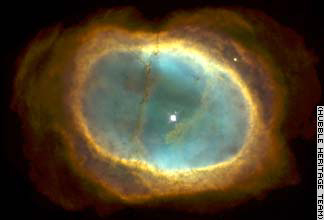
RING OF FIRE NGC 3132 Can
We "Bring a Star to Earth?"
The Fusion Energy Option
Fusion Power Associates
25th Anniversary Meeting and Symposium
December 13, 2004
Updated December 14, 2004
Many of the presentations have been collected and are posted below.
These represent work in progress and should not be quoted without
permission from the author. Questions should be directed to the
authors.
- Current Perspectives on Fossil Fuel
Reserves - John Sheffield, Joint Inst. for Energy and Environment
- Fusion as a Source for Hydrogen
Production - Ken Schultz, General Atomics
- Plans for Early Ignition on NIF -
John Lindl, Lawrence Livermore National Laboratory
- Development Paths for Inertial
Fusion Energy - Mike Campbell, General Atomics
- Status of Planning for ITER -
Ned Sauthoff, Princeton Plasma Physics Laboratory
- Status and Promise of Compact
Stellarator - Hutch Neilson, Princeton Plasma Physics Laboratory
- Status and Promise of Compact Tori and
Magnetized Target Fusion - Glen Wurden, Los Alamos National
Laboratory
- Fusion Technology R&D Needed Now
for Magnetic Fusion Energy - Neil Morley. University of California,
Los Angeles
- Status of High Average Power Laser
Program - John Sethian, U. S. Naval Research Laboratory
- Status of Z-pinch IFE Program -
Craig Olson, Sandia National Laboratory
- Status of Heavy Ion Fusion Program
- Grant Logan, Lawrence Berkeley National Laboratory
- Perspectives on Fusion Electric
Power Plants: Critical R&D Issues - Farrokh Najmabadi,
University of California, San Diego
- Thoughts on Fusion Energy Development Strategies - Dale
Meade, Princeton Plasma Physics Laboratory
- Fusion Energy Sciences Update - N.
Anne Davies, U. S. Dept. of Energy
- Inertial Confinement Fusion and the NIF
Project Update - Chris Keane, U. S. Dept. of Energy
Ring of FIRE, NGC 3132, also called the Eight-Burst Nebula or
Southern Ring Nebula, is a glowing ring of gas formed from the outer
layers of a sun-like star that experienced a cataclysmic explosion.
In this color-enhanced Hubble Space Telescope image, blue corresponds
with the hottest gases, red with the coolest. The star responsible
for this odd structure about 2,000 light-years away is not the bright
one in the middle, but a very faint one just above it.
Return to Top
FIRE home page

